Abstract
Background
Magnetic stimulation has gained relatively wide application in studying nervous system structures. This technology has the advantage of reduced excitation of sensory nerve endings, and hence results in quasi-painless action. It has become clinically accepted modality for brain stimulation. However, theoretical and practical solutions for assessment of induced current distribution need more detailed and accurate consideration.
Some possible analyses are proposed for distribution of the current induced from excitation current contours of different shape and disposition. Relatively non-difficult solutions are shown, applicable for two- and three-dimensional analysis.
Methods
The boundary conditions for field analysis by the internal Dirichlet problem are introduced, based on the vector potential field excited by external current coils. The feedback from the induced eddy currents is neglected. Finite element modeling is applied for obtaining the electromagnetic fields distribution in a non-homogeneous domain.
Results
The distributions were obtained in a non-homogeneous structure comprised of homogeneous layers. A tendency was found of the induced currents to follow paths in lower resistivity layers, deviating from the expected theoretical course for a homogeneous domain. Current density concentrations occur at the boundary between layers, suggesting the possibility for focusing on, or predicting of, a zone of stimulation.
Conclusion
The theoretical basis and simplified approach for generation of 3D FEM networks for magnetic stimulation analysis are presented, applicable in non-homogeneous and non-linear media. The inconveniences of introducing external excitation currents are avoided. Thus, the possibilities are improved for analysis of distributions induced by time-varying currents from contours of various geometry and position with respect to the medium.
Background
The theory of electromagnetic fields can be considered as quite well developed. Nevertheless, some problems could be pointed-out in connection with its application to stimulation of biological structures:
- distribution and spread of the time-varying magnetic field in non-linear and inhomogeneous domains of complex geometry;
- the interaction of electromagnetic pulses with biophysical and physiological processes;
- stationary or non-stationary processes of random and stray factors type, e.g. changes in the stimulated structure;
- technical and technological aspects, e.g. coils shape and disposition with respect to the stimulated structures.
There may be other practical and theoretical problems connected with magnetic stimulation. However, in different medical applications, various approximate or heuristic solutions were found [1].
Published studies on electromagnetic field stimulation most often are based on distribution and propagation in homogeneous media. This approach could be correct for stationary magnetic field analysis, as biological tissues relative magnetic permeability is μr approximately equal to 1. In cases of time-varying magnetic field, feedback from the induced currents may be present. However, when propagation takes place in a weakly conductive medium, the intensity of the feedback-induced magnetic field would be several orders of magnitude lower than the external field. The induced field can then be ignored, and the medium considered to be homogeneous with respect to the external magnetic field.
On the other hand, the condition of continuity of the current lines requires taking into account all regions with different specific conductivities. An exception here is the case where the induced currents propagate tangentially to the layers in a non-homogeneous medium.
In some studies, the presence of non-homogeneities has been taken into account. Transcranial magnetic stimulation, where the scalp, skull, and brain represent a layered non-homogeneous structure, is a typical example [2,3]. A theoretical approach, applying a scalar magnetic potential in addition to the vector potential has been proposed as an alternative to finite-element modeling (FEM), but has considered only a simplified basic example [4]. FEM has been used for assessment of magnetically-induced currents for heart stimulation, with inclusion of the non-homogeneities of a canine thorax [5]. Field magnitudes for efficient myocardial stimulation were computed. Magnetic flux density in the upper arm, taking into account the skin and muscle layers and the bone, have been assessed for different coil designs [6]. A study of stimulation in the spinal region [7] has shown a tendency for current density concentration about the nerve roots. However, acceptable accuracy in evaluation of the induced currents values could only be attained when these currents were assessed on the basis of an appropriately obtained magnetic field distribution. A tendency of induced current concentrations at the interfaces between structures of strongly differing conductivity could be observed [3,7].
The present work investigates some possibilities for modeling and theoretical analysis of induced current distribution during magnetic stimulation, with excitation current contours of different shape and disposition. Relatively non-difficult solution approaches are proposed, applicable for two-dimensional and three-dimensional problems of field distribution in non-homogeneous media.
Theoretical background
Initial conditions
Electrical current contours are positioned in the air above a partially homogeneous conductive medium that consists of homogeneous layers (Fig. 1), simulating part of the human body. The mean values of the electromagnetic parameters μ (magnetic permeability) and γ (specific conductivity) of the corresponding layers are assumed to be known. Each layer is taken as linear and isotropic. Effects of random factors are not considered.
Figure 1.
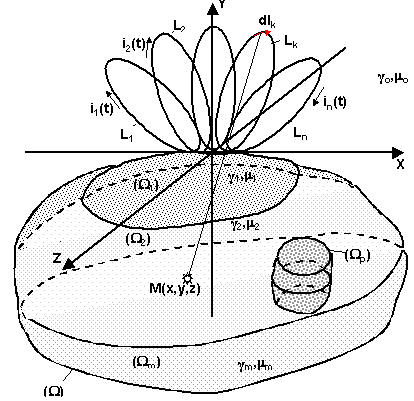
Magnetic stimulation applied on a non-homogeneous volume as a rough simulation of a human body structure. Several coil contours Li with excitation currents Ii are positioned in the air (γo and μo are the air specific conductivity and magnetic permeability) on the upper surface of the volume. The structure consists of various layers and zones Ωm of different conductivities γm and magnetic permeabilities μm.
The electrical currents in the several contours ik(t); k = 1,2,...,n are generated by an electromagnetic stimulator and create an alternating magnetic field. The distribution of the magnetic field in the examined region is described by the Maxwell equations in the form:
![]()
![]()
where, besides the field vectors  and
and  , the electromagnetic potentials
, the electromagnetic potentials  and V also take part. The last term
and V also take part. The last term  in Eq. (1) represents the independent external excitation currents ik(t), generated by a current source.
in Eq. (1) represents the independent external excitation currents ik(t), generated by a current source.
It is well known that Eqs. (1) and (2) are valid for an arbitrary medium (ε is the dielectric permittivity) and time-varying field vectors and their respective electromagnetic potentials.
The component in Eq. (1) related to the displacement current  can be ignored for quasi-stationary fields, as in the present case. Incorporating Eq. (2) in Eq. (1), and expressing
can be ignored for quasi-stationary fields, as in the present case. Incorporating Eq. (2) in Eq. (1), and expressing  by the relation
by the relation  , the following equation is obtained:
, the following equation is obtained:
![]()
Eq. (3) is valid for an arbitrary medium. Generally, the material constants in case of non-homogeneity should be considered as functions of the spacial co-ordinates and in anisotropic media – as tensor quantities. In cases of non-linear media, the material constants are functions of the field vectors.
For homogeneous linear and isotropic medium, using the Lorentz gauge [9] gives:
![]()
and the non-homogeneous diffusion equation is obtained:
![]()
It is known that in harmonic mode, this equation can be reduced to the Helmholtz equation:
![]()
Equations (5) and (6) are also applicable for partially homogeneous media, as depicted in Fig. 1. In the internal part of the non-homogeneous region Ω, where  , Eq. (5) and (6) reduce to the respective homogeneous equations. For the region external to Ω (air space), γ → 0, μ = μ0 and negligible
, Eq. (5) and (6) reduce to the respective homogeneous equations. For the region external to Ω (air space), γ → 0, μ = μ0 and negligible  , Eqs. (5) and (6) reduce to the Poisson equation:
, Eqs. (5) and (6) reduce to the Poisson equation:
![]()
The solution for stationary mode and a homogeneous medium with respect to μ, is:
![]()
For current contours of relatively small cross section and for alternate current, a known formula is obtained:
![]()
For the case shown in Fig. 1:
![]()
The conditions μ1 = μ2 = .... = μm = μ0 are respected for the different sub-regions (Ω1,Ω2,...,Ωm) of the non-homogeneous medium Ω (Fig. 1) and for the external space. The non-homogeneous medium Ω, with specific conductivities γ1 ≠ γ2 ≠ ... ≠ γp ≠ ... ≠ γm, can be of layered structure, or include internal sub-spaces Ωp. It is evident, that the feedback from the eddy currents induced in the non-homogeneous medium Ω can be neglected, compared to the direct action of the external excitation.
Induced currents in the medium
The induced field and the eddy currents in the Ω-medium are obtained by the procedure described below.
The values of the vector-potential on the external surface of Ω are computed from Eq. (10) in all nodes necessary for the solution of the internal Dirichlet problem.
Using the homogeneous equation for the diffusion, relating to the magnetic vector-potential:
![]()
or, for harmonic mode, the Helmholtz equation:
![]()
the internal Dirichlet problem is solved. The boundary conditions for the vector-potential are defined by Eq. (10) for the boundary surface SΩ of the space Ω, subjected to electromagnetic stimulation. The feedback from the induced field was ignored, as discussed above. The respective conditions are valid for refraction of the field vector lines at the boundaries of two homogeneous regions [8,9].
The solution of Eq. (10), having in view the boundary conditions, does not present theoretical or computational difficulties. The problem of field distribution in the non-homogeneous space Ω is solved by the finite element method (FEM) or by the boundary element method (BEM). Using appropriate software, the field and the currents induced by the external field in a weakly-conductive medium are obtained, together with the magnetic field of the induced currents.
Methods
In order to verify the applicability of the approach described in Section 2 above, a 3D spacial model consisting of five transverse layers was constructed, as a very approximate simulation of a biological object. The initial model consisted of 19,218 nodes and 104,693 eight-node brick elements. Two versions of the model were considered, allowing assignment of different resistivities to the respective layers, as follows:
a) homogeneous medium Ωa of specific resistivity ρ = 20 Ωm (Fig. 2a); the value was chosen as a rough average of very high and very low conductivities (soft tissue and blood; and bone and lung air, respectively).
Figure 2.
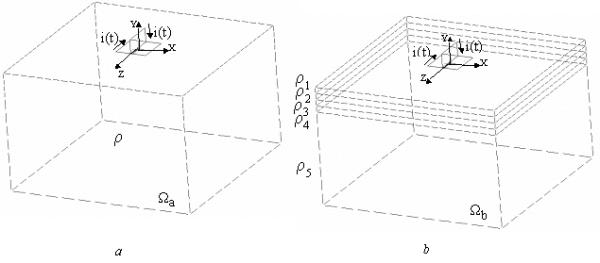
Models of (a) – homogeneous domain (Ωa) of specific resistivity ρ and (b) – a layered non-homogeneous domain (Ωb), consisting of a series of homogeneous layers of specific resistivities ρi. Vertical (in the ZOY plane) and horizontal (in the XOZ plane) rectangular excitation coil contours are positioned on the upper surface (XOZ plane).
b) non-homogeneous medium Ωb containing isotrope layers of specific resistivities (Fig. 2b), chosen to correspond to body regions [10,11], as follows:ρ1 = 20 Ωm – skin, ρ2,ρ4 = 7 Ωm – skeletal muscle, ρ3 = 160 Ωm – bone, ρ5 = 20 Ωm – 'buffer' zone needed to allow setting of adequate boundary conditions; for this test example, the layers were made of equal thickness, except for the buffer zone.
The external magnetic field was excited by a square-shaped coil. Two examples were considered initially (Fig. 2), with coils placed symmetrically on the upper surface of the 3D model: i) coil in horizontal position (XOZ plane), and ii) coil in vertical position (YOZ plane). The excitation current was arbitrarily chosen to be I = 1000 Arms, with a frequency f =10 kHz. The calculated values of the magnetic-vector-potentials were applied on the upper surface nodes of the model (1011 nodes), as magnetic boundary loads. Zero boundary conditions were adopted for the other surfaces. Harmonic magnetic analysis was performed to obtain the eddy currents distribution in the medium.
Results
The magnetic vector-potential distributions, induced by the horizontal and vertical current contours on the upper XOZ surface of the 3D model, are shown respectively in Fig. 3a,3b. The excited magnetic fields, viewed in a central XOY section and on the XOZ plane, are presented in Fig. 4a,4b for the corresponding current coil dispositions. Due to the homogeneous character of the layered structure with respect to the magnetic permeability μ, and the neglected induced currents feedback, the external magnetic field distribution is not influenced by the non-homogeneities of the domain with respect to the specific conductivity γ.
Figure 3.
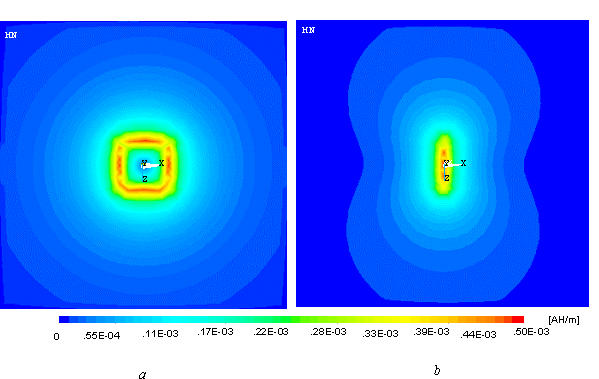
Magnetic vector-potential distribution, with potentials applied at the XOZ nodes. The excitation current I = 1000 A, f = 10 kHz flows in horizontally (a) or vertically (b) positioned coils.
Figure 4.
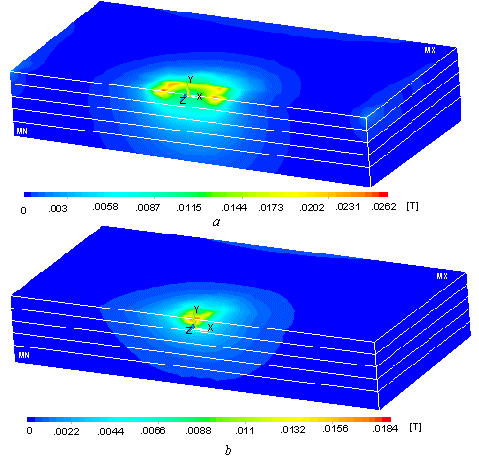
Distribution of the external magnetic field in the non-homogeneous model domain, excited by the current in horizontally (a) and vertically (b) positioned coils. The viewing angle shows the vertical (XOY) section and the upper horizontal plane (XOZ).
The magnetic fields excited by the induced currents in a non-homogeneous medium, from a horizontal and a vertical coil dispositions are shown in Figs. 5a,5b. The distribution of the eddy currents induced by a horizontal current contour in the homogeneous and non-homogeneous domains are shown in Fig. 6a,6b, respectively. The same distributions for the vertical coil are presented in Fig. 7a,7b.
Figure 5.
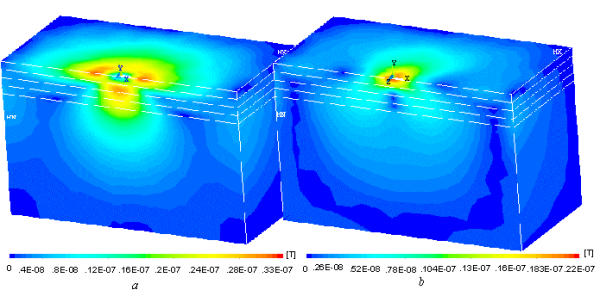
Distribution of the modulus of the magnetic field of the induced currents, excited by the horizontally (a) and vertically (b) positioned coils. Section and viewing angle – as in Fig. 4.
Figure 6.
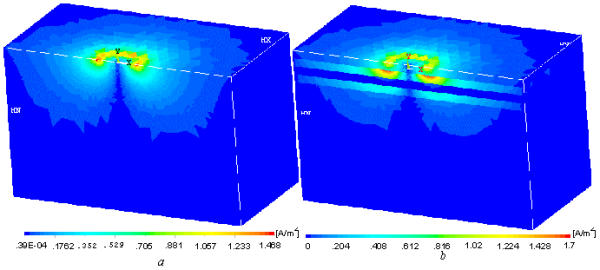
Distribution of the modulus of the current density vector in the homogeneous (a) and non-homogeneous (b) domains from a horizontally positioned coil. Section and viewing angle – as in Fig. 4,5.
Figure 7.
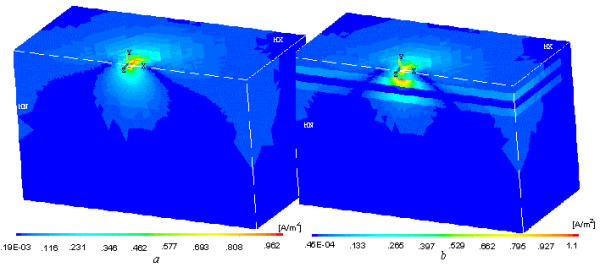
Distribution of the modulus of the current density vector in the homogeneous (a) and non-homogeneous (b) domains from a vertically positioned coil. Section and viewing angle – as in Fig. 4,5,6.
It was found that the current lines tend to form loops in the low resistivity layers, in addition to running in opposition to the excitation current, as would be in an homogeneous medium. In order to better observe the induced current lines across layers of different resistivities, the non-homogeneity is modeled by vertical layers and the coil position is on the upper surface of the medium, in the XOZ plane (Fig. 8). The effect of more complicated current contours can also be studied. The distribution of the induced vector-potential by the fan-like assembly (slinky coils, [12]), viewed from the upper XOZ surface, is shown in Fig. 9. The corresponding eddy currents distributions in the homogeneous and non-homogeneous media are shown in Fig. 10a,10b.
Figure 8.
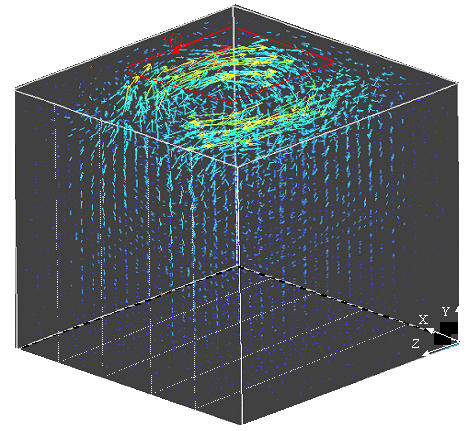
Current density vector distribution obtained from a horizontally positioned (XOZ plane) coil in a vertically-sliced non-homogeneous volume.
Figure 9.
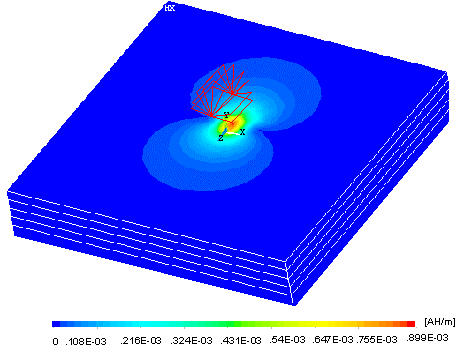
Magnetic vector-potential distribution on the domain surface (XOZ), excited by rectangular coils in a fan-like assembly (slinky coils).
Figure 10.
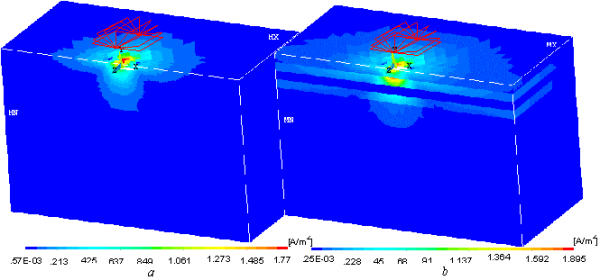
Current density vectors distribution, excited by rectangular coils in a fan-like assembly in the homogeneous (a) and non-homogeneous (b) domains. Section and viewing angle as in Figs. 4,5,6,7.
Discussion
The approach proposed in Section 2.2 considerably reduces the problems connected with generation of 3D FEM networks. However, this approach preserves the power for analysis in non-homogeneous and, in non-linear media. The inconveniences of introducing external excitation currents are avoided. Thus, the possibilities are improved for analysis of field distributions induced by different time-varying currents, with contours of various geometry and position with respect to the stimulated object.
A systematic error is introduced due to the ignored feedback from the eddy currents. However, this error is negligible, considering the low intensity of the eddy currents in the weakly conductive medium. These currents have their own magnetic field, which is several orders of magnitude lower than the external magnetic field from the stimulation coils, as can be seen in comparing the distributions in Fig. 5 and Fig. 4.
There exist theoretical possibilities by using an iteration procedure [e.g. [13]], for taking into account the feedback. Such a technique has been used in the development and practical application of numerical methods for field analysis. However, in the case of weakly conductive media, the iteration just stops at the first cycle.
The different field structures in homogeneous and non-homogeneous media are evident, as well as the relative difference in the current density amplitude values. The latter reach about 15% for horizontal and vertical contours. However, the difference is much more pronounced in some non-homogeneous regions (Figs. 6 and 7). It can be seen that the non-homogeneous structure has an essential influence on the induced currents distribution and on the differences in the current density vector.
An interesting event can be observed in relation to the distribution of the current density. The current lines follow low resistivity paths and in addition to crossing from layer to layer, flowing in opposition to the excitation current, they also rotate inside the low resistivity layer. In order to better illustrate this specific distribution, an example with vertical layers is shown in Fig. 8. Current lines forming loops in the vertical layers can be observed.
Analysis of the results shows, that the method and procedure adopted, introducing boundary conditions in the non-homogeneous domain, is workable. This method could also be applied for other coil shapes and domain structures, without any essential difficulties. Two examples with slinky coils (Fig. 9 and 10) demonstrate the versatility of this method.
The fields resulting from the external coils and the fields created by the induced currents differ by many orders of magnitude (six in our examples), due to the relatively low conductivities of the medium and to the moderately high frequencies. Therefore, ignoring the feedback effects with respect to the introduced boundary condition in solving the internal Dirichlet problem, is justified.
The boundary conditions, related to the components Ax,Ay,Az of the magnetic vector-potential, can be considered invariant with respect to the co-ordinates.
Another point of interest is that a concentration of induced current densities can be observed at the interface (boundary) between structures of differing conductivities. Hence, a kind of concentration or selective stimulation (focusing) could be predicted or looked for, in structures with relatively well-defined layers of different resistivity (Figs. 6b, 7b and 10b). The concentration in question can be explained by the appearance of surface charges on these boundaries.
It should be reminded here, that the results were obtained for sinusoidal excitation currents. The application of the method for other types of time-varying currents could be addressed by adequate modeling software. The same was valid for studying field distributions in weakly conducting non-linear media.
Conclusion
The results obtained in this work do not provide data that would change the theory or practice of magnetic stimulation. However, our findings can be used to enhance concepts related to electromagnetic field distribution in non-homogeneous structures.
For magnetic stimulation of biological targets embedded in electrically non-homogeneous media, it is helpful to decide upon external system geometry and parameters by considering an accurately obtained distribution of the induced current fields.
The complex interaction between external magnetic field and physiological processes should not deter the search for improved methods for more accurate assessment of the induced currents.
Authors' contributions
SP was responsible for the theoretical basis of the investigation. VK solved the problems of adequate FEM modeling and carried-out the generation and presentation of various field and current distributions. ID was responsible for setting and formulation of the problem and for the biomedical engineering aspect of the study. All authors read and approved the final manuscript.
Acknowledgments
Acknowledgements
The authors thank the Technical University of Sofia for granting use of the FEM software.
Contributor Information
Vessela T Krasteva, Email: vessika@clbme.bas.bg.
Sava P Papazov, Email: papasow@vmei.acad.bg.
Ivan K Daskalov, Email: ikdas@argo.bas.bg.
References
- Stuchly MA. Applications of time-varying magnetic fields in medicine. Crit Rev Biomed Eng. 1990;18:89–124. [PubMed] [Google Scholar]
- Cohen D, Cuffin BN. Developing a more focal magnetic stimulator. Part I: Some basic principles. J Clin Neurophysiol. 1991;8:102–111. doi: 10.1097/00004691-199101000-00013. [DOI] [PubMed] [Google Scholar]
- Nakayama H, Kiyoshi T, Wada H, Yunokuchi K, Tamari Y. 3-D analysis of magnetic stimulation to human cranium. 12th Internat Conf on Biomagnetism, Aug 13–17, Espoo, Finland, paper 0663. 2000. http://biomag2000.hut.fi/papers/0663
- Davey KR, Cheng CH, Epstein CM. Prediction of magnetically induced electric fields in biological tissue. IEEE Trans Biomed Eng. 1991;38:418–422. doi: 10.1109/10.81560. [DOI] [PubMed] [Google Scholar]
- Ragan PM, Wang W, Eisenberg SR. Magnetically induced currents in the canine heart: A finite element study. IEEE Trans Biomed Eng. 1995;42:1110–1116. doi: 10.1109/10.469378. [DOI] [PubMed] [Google Scholar]
- Al-Mutawaly N, de Bruin H, Findlay RD. Magnetic nerve stimulation: Field focality and depth of penetration. Proc 23rd Ann Conf IEEE/EMBS Istanbul, Turkey, paper No 1106. Oct 25–28 2001.
- Maccabee PJ, Amassian VE, Eberle LP, Rudell AP, Cracco RQ, Lai KS, Somasundarum M. Measurement of the electric field induced into inhomogeneous volume conductors by magnetic coils: application to human spinal neurogeometry. Electroencephalogr Clin Neurophysiol. 1991;81:224–37. doi: 10.1016/0168-5597(91)90076-A. [DOI] [PubMed] [Google Scholar]
- Stratton JA. Electromagnetic theory. McGraw-Hill Book Co; 1941. [Google Scholar]
- Ulaby FT. Applied electromagnetics. Prentice Hall. 1999.
- Jorgenson DB, Haynor DR, Bardy GH, Kim Y. Computational studies of transthoracic and transvenous defibrillation in a detailed 3-D human thorax model. IEEE. 1995;42:172–183. doi: 10.1109/10.341830. [DOI] [PubMed] [Google Scholar]
- Panescu D, Webster JG, Tompkins WJ, Stratbucker RA. Optimization of transcutaneous cardiac pacing by three-dimensional finite element modelling of the human thorax. Med & Biol Eng & Comp. 1995;33:769–775. doi: 10.1007/BF02523008. [DOI] [PubMed] [Google Scholar]
- Ren C, Tarjan PP, Popovic DB. A novel electric design for electromagnetic stimulation – The slinky coil. IEEE Trans Biomed Eng. 1995;42:918–925. doi: 10.1109/10.412658. [DOI] [PubMed] [Google Scholar]
- Heymann F. Ueber die Anwendung der Iterationsmethode zur angenaherten Berechning des Wirbelstroeme und des Wirkwiderstandes. 1995. pp. 329–336.


